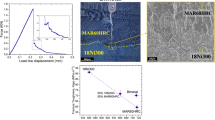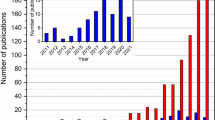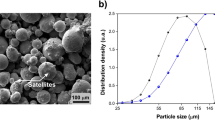Abstract
The present paper addresses the phenomena of hot cracking of nickel-based superalloys in the perspective of hybrid Laser Metal Deposition (combined application of induction and laser). This includes an extract of relevant theoretical considerations and the deduction of the tailored approach which interlinks material–scientific aspects with state-of-the-art manufacturing engineering. The experimental part reflects the entire process chain covering the manufacturing strategy, important process parameters, the profound analysis of the used materials, the gradual process development, and the corresponding hybrid manufacture of parts. Furthermore, hot isostatic pressing and thermal treatment are addressed as well as tensile testing at elevated temperatures. Further investigations include X-ray CT measurements, electron backscattered diffraction (EBSD), and scanning electron microscopy (SEM) as well as light optical microscope evaluation. The fundamental results prove the reliable processibility of the high-performance alloys Mar-M-247 and Alloy 247 LC and describe in detail the process inherent microstructure. This includes the grain size and orientation as well as the investigation of size, shape, and distribution of the γ′ precipitates and carbides. Based on these findings, the manufacturing of more complex demonstrator parts with representative dimensions is addressed as well. This includes the selection of a typical application, the transfer of the strategy, as well as the proof of concept.

























Similar content being viewed by others
References
R. Reed: The Superalloys Fundamentals and Applications, Cambridge University Press, Cambridge, 2006.
M.M. Coporation: Nickel Base Alloy. USA Patent 3720509, 14 Dezember 1970.
Al. Gunderson, S.J. Setlak, and W.F. Brown: Aerospace Structural Metals Handbook, vol. 6, CINDAS LLC, West Lafayette, Indiana, 2007 (Revised).
C. Yan, L. Zhengdong, A. Godfrey, L. Wei and W. Yuging: Materials Science and Engineering A, 2014, vol. 30, issue 2, pp. 153–164.
C.H. Tsai, and W. Weite: Metallurgical and Materials Transactions A, vol. 30, issue 2, 1999, pp. 417–26.
A. Hübner: Untersuchungen über den Einfluss und die Wirkungen von Stickstoffzusätzen im Schutzgas auf das Heißrissverhalten ausgewählter heißrissempfindlicher Nickel-Basiswerkstoffe, Magdeburg, Otto-von-Guericke-Universität Magdeburg (Diss.), 2005.
U. Dilthey: Schweißtechnische Fertigungsverfahren 2 - Verhalten der Werkstoffe beim Schweißen, vol 3, Aachen, Springer Verlag, 2005.
W. Liu, X. Tian, and X. Zhang: Weld. J. (Weld. Res. Suppl.), 1996, pp. 297–304.
X. Cao, B. Rivaux, M. Jahazi, J. Cuddy and A. Birur: Journal of Materials Science, 2009, vol. 44, pp. 4557-4571.
E.M. Lehockey, G. Palumbo, and P. Lin: Metall. Mater. Trans. A, vol. 29A, issue 12, 1998, pp. 3069–79.
G. Göbel: Erweiterung der Prozessgrenzen beim Laserstrahlschweißen heißrissgefährdeter Werkstoffe. Dresden & Stuttgart, Technische Universität Dresden (Diss.), 2008.
F. Brückner: Modellrechnungen zum Einfluss der Prozessführung beim induktiv unterstützten Laser-Pulver-Auftragschweißen auf die Entstehung von thermischen Spannungen, Rissen und Verzug. Dresden, Technische Universität Dresden (Diss.), 2011.
A. Seidel: Heißrissreduzierung durch magnetofluiddynamische Maßnahmen beim Laserauftragschweißen am Beispiel der Nickelbasis-Superlegierung Mar-M-247. Thesis, Dresden, Technische Universität Dresden, 2014 (pursuing http://gepris.dfg.de/gepris/projekt/396298896).
K. Gupta, N.K. Jain, and R.F. Laubscher: Hybrid Machining Processes: Perspectives on Machining and Finishing, Springer International Publishing AG, 2016.
W. Grzesik: Advanced Machining Processes of Metallic Materials: Theory, Modelling, and Applications, vol 2, Elsevier, San Diego, 2016.
E. Beyer: Schweißen mit Laser - Grundlagen. Springer, Berlin, 1995.
D. Lepski, and F. Brückner: Laser Cladding. The Theory of Laser Materials Processing—Heat an Mass Transfer in Modern Technology, Springer, Dresden, 2009, pp. 235–79.
C. S. Wu: Welding Thermal Processes and Weld Pool Behaviors, London, CRC Press, 2010.
D. M. Stefanescu: Science and Engineering of Casting Soldification, Second Edition, Columbus Ohio USA, Springer Science+Business Media, LLC, 2009.
S. Kou: Welding Metallurgy, Wisconsin, Wiley Interscience, 2003.
W. Kurz, and D. Fisher: Fundamentals of Soldification, Fourth Revised Edition, Lausanne, Trans Tech Publications Ltd, 2005 (Reprinted).
R. Bürgel, Hans J. Maier and T. Niendorf: Handbuch Hochtemperatur-Werkstoffe Grundlagen, Werkstoffbeanspruchungen, Hochtemperaturlegierungen und –beschichtungen, vol 4, Wiesbaden, Vieweg+Teubner Verlag, 2011.
T.M. Pollock, W.H. Murphy, E.H. Goldman, D.L. Uram, and J.S. Tu: Superalloys 1992, Proc. 7th Int. Symp. on Superalloys, Seven Springs/Pa., The Minerals, Metals & Materials Society, Warrendale/Pa., 1992, pp. 125–34.
M. A. Taha and W. Kurz: About Microsegregation of Nickel Base Superalloys, Zeitschrift für Metallkunde 72, 1981, pp. 546–549.
D. Ma and P. R. Sahm: Einkristallerstarrung der Ni-Basis-Superlegierung SRR99, Teil2: Mikroseigerungsverhalten der Legierungselemente, Zeitschrift für Metallkunde 87, 1996, pp. 634– 639.
M.S.A. Karunaratne, D.C. Cox, P. Porter, and R.C. Reed, Superalloys 2000, Proc. 9th Int. Symp. on Superalloys, Seven Springs/Pa., The Minerals, Metals & Materials Society, Warrendale/Pa., 2000, pp. 263–72.
A. R. E Singer and P. H. Jennings: J. Inst. Met.,1947, vol 74, pp. 197-212.
H. F. Bishop, C. E. Ackerland and S. W. Pellini: Trans. Am. Foundry Soc., 1952, vol. 60, pp. 818-913.
W. S. Pellini: Foundry, 1952, vol. 80, pp. 125-199.
C. Borland: Br. W. J.,1960, vol. 7, pp. 508-512.
M. Rappaz, J. M. Drezet and M. Gremaud: Metall. Mater. Trans. A, vol. 30A, 1999, pp. 449–55.
S. Bonss, M. Seifert, J. Hannweber, U. Karsunke, S. Kühn, D. Pögen, and E. Beyer: Invited Paper at the 9th International Conference on Photonic Technologies LANE 2016, Physics Procedia, vol. 83, pp. 1–1450.
Ken-Tu Hsu, Huei-Sen Wang, Wei Bin He, Chen-Ming Kuo, Hui-Yun Bor and Chao-Nan Wei: Supplemental Proceedings: Materials Properties, Characterization, and Modeling, vol. 2, 2012, pp. 667-672.
DIN EN ISO 6892-2:2011-05, Metallic materials—Tensile testing—Part 2: method of test at elevated temperature (ISO 6892-2:2011).
M. V. Nathal and R. A. Mackay: Acta Metallurgica et Materialia, vol. 39, 1991, pp. 2771-2781.
R. Baldan, C. A. Nunes, M. J. R. Barboza, A. M . S. Costa, R. Bogado and G. C. Coelho.: Int. Conf. Adv. Mater., vol 11, 2009, pp. 56-67.
J. Davids.: Heat-Resistant Materials, The Materials Information Society, Materials Park, Ohio, 1997.
A. Basak and S. Das: Journal of Alloys and Compounds, vol. 705, 2017, pp. 806-816.
X. Wang,N. Luke. B. Pang Carter, Moataz M. Attallah and Michael H. Loretto, Acta Materialia, vol. 128, 2017, pp 87-95.
J.R. Kattschuk: MAR-M247, Aerospace Structural Metals Handbook, 1999, pp. 1–7.
P. Heuler and H. Huff: Niedrigschwingspielzahl-Ermüdung (LCF) von Turbinenrädern aus Nickelbasis-Gußwerkstoffen Teil II: Untersuchungen an dem Werkstoff MAR-M247 LC FK HIP, Final report for the FVV-project Nr. 438, Industrieanlagen-Betriebsgesellschaft mbH (IABG), Fraunhofer-Institut für Betriebsfestigkeit (LBF), Darmstadt, 1994.
D. Gelmedin and K.H. Lang: Ermüdungsverhalten von Hochtemperaturwerkstoffen bei hohen Grundlasten, Final report for the FVV-project Nr. 867, Institut für Werkstoffkunde I, Universität Karlsruhe, 2010.
M. Prager and C. S. Shira: Welding of Precipitation Hardening Nickel-Base Alloys, Weld Research Council Bulletin, vol. 6, 1968, pp. 128-155.
J.M. Kalinowski: Weldability of a Nickel-Based Superalloy, NASA Contractor Report 195376, August 1994.
G. Cam and M. Kocak, International Materials Reviews, vol. 43, 2013, pp. 1-44.
A. Basak and S. Das: JOM, vol. 70, 2018, pp. 53-59.
Author information
Authors and Affiliations
Corresponding author
Additional information
Manuscript submitted March 13, 2018.
Rights and permissions
About this article
Cite this article
Seidel, A., Finaske, T., Straubel, A. et al. Additive Manufacturing of Powdery Ni-Based Superalloys Mar-M-247 and CM 247 LC in Hybrid Laser Metal Deposition. Metall Mater Trans A 49, 3812–3830 (2018). https://doi.org/10.1007/s11661-018-4777-y
Received:
Published:
Issue Date:
DOI: https://doi.org/10.1007/s11661-018-4777-y




